m (Reverted edits by Beerparty (talk | block) to last version by Arvan Swordwielder) |
No edit summary |
||
| Line 67: | Line 67: | ||
Several years after ascending his throne, Caspian X lead a voyage aboard the [[Dawn Treader]] to find Aslan’s Country at the end of the world and to find the seven lost lords. Aslan called Edmund and Lucy Pevensie and [[Eustace Scrubb]] from Earth to join him on his voyage, in order to teach them important personal lessons. On [[Deathwater Island]], Aslan helped Caspian, Edmund, and Lucy learn to resist greed. Aslan helped Lucy to come to terms with her insecurities and need to be beautiful. Aslan turned Eustace into a dragon in order to help him realize his own flaws and self-righteousness. |
Several years after ascending his throne, Caspian X lead a voyage aboard the [[Dawn Treader]] to find Aslan’s Country at the end of the world and to find the seven lost lords. Aslan called Edmund and Lucy Pevensie and [[Eustace Scrubb]] from Earth to join him on his voyage, in order to teach them important personal lessons. On [[Deathwater Island]], Aslan helped Caspian, Edmund, and Lucy learn to resist greed. Aslan helped Lucy to come to terms with her insecurities and need to be beautiful. Aslan turned Eustace into a dragon in order to help him realize his own flaws and self-righteousness. |
||
| − | Once the Dawn Treader reached the sweet waters, Aslan ordered Caspian through a dream to send Edmund, Lucy, Eustace, and the talking mouse [[Reepicheep]] to the shore at the end of the world. Here, Aslan allowed Reepicheep to pass on from Narnia to Aslan’s Country, as was his greatest dream, and sent the others homes. |
+ | [[File:32.jpg|thumb]]Once the Dawn Treader reached the sweet waters, Aslan ordered Caspian through a dream to send Edmund, Lucy, Eustace, and the talking mouse [[Reepicheep]] to the shore at the end of the world. Here, Aslan allowed Reepicheep to pass on from Narnia to Aslan’s Country, as was his greatest dream, and sent the others homes. |
===Search for Prince Rilian=== |
===Search for Prince Rilian=== |
||
Revision as of 12:54, 18 July 2012

|
"Every stick and stone you see, every icicle… is Narnia!"
This article "Aslan" needs major expansion and/or editing. Feel free to contribute and help build up (or reconstruct) this page. Click here to edit this page. |
Aslan, the Great Lion, is the creator and one true king of the world of Narnia, and generally a figure of all that is good.

Attributes
- "He'll be coming and going. One day you'll see him and another you won't. He doesn't like being tied down - and of course he has other countries to attend to. It's quite all right. He'll often drop in. Only you mustn't press him. He's wild, you know. Not like a tame lion."
- ―Mr. Beaver[src]
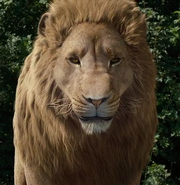
Aslan's return in Prince Caspian
As he appears in Narnia, Aslan is a large talking lion who is terrifying, magnificent, and beautiful all at once. Aslan appears different sizes to different people, such that he is always larger than everyone; as people grow, he grows with them. Aslan is very wise, and a powerful force for good, but as Narnians often say, “he’s not a tame lion.” He can be dangerous, and is an unconquerable enemy.
Aslan is the one true king of Narnia; all of its inhabitants have faith in him and obey him absolutely. Generally, Aslan comes to Narnia to aid its leaders and heroes on important missions for external and personal peace, and to protect it from various evils. He watches over Narnia constantly, although he does not choose to solve all of its problems for its inhabitants. Aslan also periodically brings humans from Earth to Narnia, both to help Narnia and to teach them important lessons.
Aslan is a divine being, and therefore is very powerful. He possesses a certain omnipresence, and he can manipulate, transport and heal. He can manifest himself in different shapes. His breath is known heal those who have been petrified, and boost the morale of the faithless.
The only limits to Aslan’s abilities and autonomy in Narnia are the Deep Magic from the Dawn of Time and the Deeper Magic from Before the Dawn of Time.
Aslan is the son of the Emperor-Over-The-Sea, and comes from the land or world – its exact nature is unknown – known as Aslan’s Country.
History
Template:Spoiler
This is Aslan’s history as we can trace it through the books. He did much else in the gaps between these accounts.
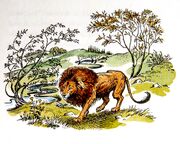
Aslan sings the world of Narnia into existence.
Creation of Narnia
- "Narnia, Narnia, Narnia, awake. Love. Think. Speak. Be walking trees. Be talking beasts. Be divine waters."
- ―Aslan at the creation of Narnia[src]
Aslan created the world of Narnia in the Earth year 1900. He brought everything –from the creatures, to the landscapes, to the sky and the stars – into being from an empty dark void by singing and roaring. Narnia was made in the image of Aslan’s Country, the “real” Narnia, although it was nothing more than a shadow compared to the latter’s glory. At the creation of Narnia, Aslan also witnessed the writing of the Deep Magic from the Dawn of Time by his father, the Emperor-Over-the-Sea.
Aslan choose two specimens, one male and one female, of each species of dumbs beasts inhabiting Narnia upon which to endow the powers of thought and speech. This council eventually spawned the races of talking beasts that populated Narnia for many, many years afterwards.
Aslan crowned Frank and his wife, Helen, two humans from Earth, the first King and Queen of Narnia. It is clear that all humans in Narnia are the descendants of Frank and Helen, and therefore originate from Earth.
Aslan banished Jadis, a half-Jinn, half-giant from the world of Charn, to the northern land of Ettinsmoor.
Aslan ordered Digory Kirke, a human from Earth in Narnia at the time, to fetch an apple from the Tree of Youth, from whose seeds grew the Tree of Protection, from which in turn he allowed Digory to take an apple to Earth in order to heal his sick mother. This apple’s seeds eventually grew into the tree whose wood would become the wardrobe.

Winter Revolution
- "When Aslan bares his teeth, winter meets its death, and when he shakes his mane, we shall have spring again."
- ―The sword Rhindon

When the four Pevensies first came to Narnia, heralding the fulfillment of the prophecy of Cair Paravel, Aslan returned to Narnia in order to aid them in their fight against the wrongful queen, the White Witch. His presence brought an end to the Long Winter. Upon arrival, Aslan began gathering all those still faithful to him near the Stone Table.
Aslan greeted Peter, Susan, and Lucy Pevensie upon their arrival at Aslan’s How, and knighted Peter to the Most Noble Order of the Lion as Sir Peter Wolfsbane after he killed Maugrim. He sent the best of his army to rescue Edmund Pevensie from the clutches of the White Witch.
But according to the laws of the Deep Magic, it was the White Witch’s right to sacrifice Edmund, as he was a traitor. In order to save Edmund, Aslan agreed to be sacrificed in his stead. However, according to the laws of the Deeper Magic, Aslan, as an innocent victim, was resurrected. Upon his resurrection, Aslan revived the petrified Narnians in the White Witch’s castle and led them into the first Battle of Beruna, which he quickly resolved by killing the White Witch.
Aslan revived those who had been petrified in the battle and crowned the Pevensies as Kings and Queens of Narnia before disappearing.
Cor and Aravis
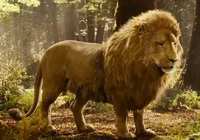
During the Golden Age, Aslan returned briefly to Narnia to help Cor, Aravis, and the talking horses Bree and Hwin escape Calormen for the freedom of Narnia. In the process, he helped Cor discover his identity as a prince of Archenland, taught Aravis to abandon her pride and faith in the Calormene god Tash, and helped stop Rabadash from conquering Narnia.
Narnian Revolution
Aslan was absent from Narnian during the Telmarine Conquest, and therefore most of the hunted and oppressed Narnians lost faith in him. However, when the Pevensies were transported to Narnia by Susan's horn, Aslan returned, and slowly tried to get them to believe in him. Although they did not follow him at first, they eventually trusted him once more, and accordingly, Aslan awoke the hibernating Narnians and called forth a river-god to end the second Battle of Beruna.
Aslan blessed Caspian X as the next king of Narnia, and returned many of the conquered Telmarines to Earth to make a new life.
Search for Aslan's Country and the Seven Lost Lords
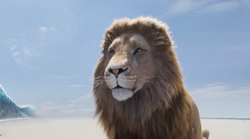
Aslan on the shore at the end of the world.
Several years after ascending his throne, Caspian X lead a voyage aboard the Dawn Treader to find Aslan’s Country at the end of the world and to find the seven lost lords. Aslan called Edmund and Lucy Pevensie and Eustace Scrubb from Earth to join him on his voyage, in order to teach them important personal lessons. On Deathwater Island, Aslan helped Caspian, Edmund, and Lucy learn to resist greed. Aslan helped Lucy to come to terms with her insecurities and need to be beautiful. Aslan turned Eustace into a dragon in order to help him realize his own flaws and self-righteousness.
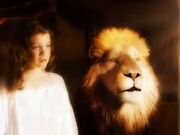
Once the Dawn Treader reached the sweet waters, Aslan ordered Caspian through a dream to send Edmund, Lucy, Eustace, and the talking mouse Reepicheep to the shore at the end of the world. Here, Aslan allowed Reepicheep to pass on from Narnia to Aslan’s Country, as was his greatest dream, and sent the others homes.
Search for Prince Rilian
Caspian X’s wife, Ramandu's daughter, was killed by the Lady of the Green Kirtle, and his only son, Prince Rilian was kidnapped by the same witch; she planned to use him to slowly conquer Narnia. An old man, Caspian X in search of Aslan to ask him who should ascend the throne of Narnia after he died, believing that Rilian was lost.
Aslan, knowing that Rilian was alive, but hypnotized by the Lady of the Green Kirtle’s Silver Chair, brought Eustace Scrubb and Jill Pole to Narnia and ordered them to find him. They eventually succeeded, but Caspian had by that time died; Aslan took him to Aslan’s Country, a young man once more.
Destruction of Narnia
- "Peter, High King of Narnia: Close the door."
- ―Aslan at the destruction of Narnia[src]
During the rule of King Tirian, most of the inhabitants of Narnia fell prey to a lie that the donkey Puzzle was Aslan, and that Aslan and the demon Tash, whom the Calormenes worshipped, and were the same being. A great war between the Calormenes and the Narnians ravaged all the lands.
Aslan came to Narnia for the last time, and destroyed the entire world. He passed judgment of every one of its inhabitants, allowing those who were faithful, good, and innocent to pass into Aslan’s Country, where they would exist in eternal peace, and leaving the rest to an unknown fate. Aslan also caused a train crash that brought the Seven Friends of Narnia and Mr. and Mrs. Pevensie to Narnia and killed them on Earth. He ordered Peter Pevensie to “close the door” on Narnia forever, and admitted them all to Aslan’s Country.
Notably, Aslan chose not to kill Susan Pevensie and bring her to Aslan’s Country as well. She did not believe in Aslan or Narnia at the time. It is considered likely that she later remembered the truth, and would one day enter Aslan's Country.
In Other Worlds
- "But there I have another name. You must learn to know me by that name. This was the very reason you were brought into Narnia, that by knowing me here for a little, you might know me better there."
- ―Aslan on Earth[src]
As seen in The Magician's Nephew, there is more than one world than Narnia. There are a vast number of parallel universes with their own lands, inhabitants, and laws, all of which are accessible from the Wood between the Worlds.
It is indicated that Aslan exists in all the worlds as some sort of divine figure of good. His manifestation is different in each world, as are his specific attributes and abilities. It is clear that on Earth, Aslan is Jesus Christ. C.S. Lewis writes in The Last Battle that in Aslan’s Country, Aslan no longer looks like a lion. It is unknown what shape he takes there, and in all the other worlds.
Portrayals in Adaptations
In the 1988 BBC television adaptation of The Lion, the Witch and the Wardrobe, Aslan was voiced by Ronald Pickup.
In the 2005 film The Chronicles of Narnia: The Lion, the Witch and the Wardrobe, the 2008 film Prince Caspian, and the 2010 film The Voyage of the Dawn Treader, he is voiced by Liam Neeson.
In the Focus on the Family Radio Plays, he is voiced by David Suchet[1].
Trivia
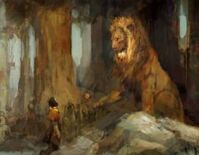
Artwork from the Prince Caspian film of Aslan with Caspian X.
- Lewis originally did not intend for Aslan to appear in any of the books, until the form of a lion appeared to him in a dream one night.
- Lewis attempts to convey something of the ineffable mystery of the divine by frequently reminding his readers that "Aslan is not a tame lion."
- The words "aslan" and "arslan" are Turkish for "lion".
- Aslan appears in all seven books of the Chronicles of Narnia, the only character to do so.
- Aslan represents Jesus Christ, according to the author, C. S. Lewis. C.S. Lewis uses the allegory in the books that Aslan is the Lion and the Lamb, also said in the Bible about God.
- Aslan is said to have nine names but not all of them are given in the series.
- His might went hand in hand with his kindness because he was in essence the Father of Narnia.
- In Aslan's Country in The Last Battle, Lucy finds Aslan no longer looks like a lion, but we are not told what he looks like. There have been suggestions that he takes the form of a human - Jesus - since in The Voyage of the Dawn Treader, Lucy and Edmund are told by Aslan that they must learn to recognize him in their world.
- Lucy is the closest to Aslan and sees him most often.
